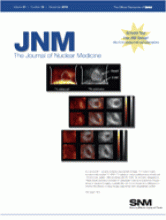Abstract
The utility of 18F-FDG PET/CT for response assessment in malignant lung tumors treated with radiofrequency ablation (RFA) and for the detection and prediction of local recurrence was investigated. Methods: Between December 17, 2003, and April 9, 2008, 68 consecutive patients (mean age, 68 y) with 94 pulmonary lesions, including metastases (n = 38) and primary lung cancers (n = 44), underwent RFA. Because of inadequate imaging follow-up in 12 patients, only 82 lesions were analyzed (CT scans, n = 82; 18F-FDG PET/CT scans, n = 62). The median follow-up was 25 mo (range, 12–66 mo). A baseline study was defined as 18F-FDG PET/CT performed no more than 3 mo before RFA. The first postablation scan was defined as PET/CT performed between 1 and 4 mo after RFA; additional follow-up studies were obtained in some cases between 6 and 12 mo after RFA. The unidimensional maximum diameter of the lesion was recorded on a pretherapy diagnostic CT scan or on the CT component of a pretherapy 18F-FDG PET/CT scan, whichever was obtained most recently, using lung windows. Maximum standardized uptake values (SUVs) were recorded for all lesions imaged by 18F-FDG PET/CT. 18F-FDG uptake patterns on post-RFA scans were classified as favorable or unfavorable. Survival and recurrence probabilities were estimated using the Kaplan–Meier method. Uni- and multivariate analyses were also performed. Results: Before RFA, factors predicting greater local recurrence-free survival included initial lesion size less than 3 cm (P = 0.01) and SUV less than 8 (P = 0.02), although the latter was not an independent predictor in multivariate analysis. Treated metastases recurred less often than treated primary lung cancers (P = 0.03). Important post-RFA factors that related to reduced recurrence-free survival included an unfavorable uptake pattern (P < 0.01), post-RFA SUV (P < 0.01), and an increase in SUV over time after ablation (P = 0.05). Conclusion: 18F-FDG PET/CT parameters on both preablation and postablation scans may predict local recurrence in patients treated with RFA for lung metastases and primary lung cancers.
- © 2010 by Society of Nuclear Medicine







